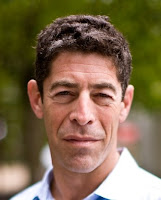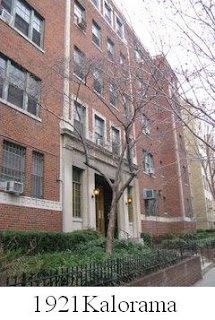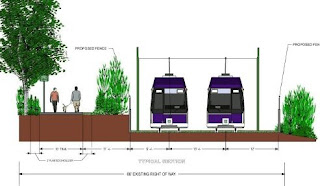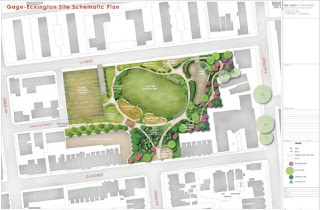Since co-founding
Urban Investment Partners (UIP) at the turn of the millennium,
 UIP principal Steve Schwat
UIP principal Steve Schwat has overseen a diverse portfolio of real estate and development projects in Washington, DC and Prince George's County. In addition to owning and/or managing roughly 2800 rental units throughout the city, the firm has developed several for-sale condo projects, including
The Archbold in Glover Park and
Providence Square on Capitol Hill.
As the area condo market began its steep descent a few years back, UIP turned its focus to a practice Schwat calls the "value add" - a program that provides "substantial rehabilitation" to blighted or vacant buildings with updated amenities and streamlined utility systems. Schwat spoke with DCmud about UIP's expanding list of services and the state of DC development in general from their newly acquired Connecticut Avenue offices, directly beneath one such "value add" property currently under renovation: the historic Macklin apartment complex at 2911 Newark Street, NW.
Can you tell us a bit about how UIP came together and the work you do here at the firm?
I’m one of the original principals. There are three of us. We started back around 2000 and I have been in Washington since 1980, when I went to school at GW. I’m serial entrepreneur of sorts. I’ve owned a number of different businesses and I have a background in sales. My initial interest in real estate was doing single-family homes, and then I did my first condominium project in the early 80s, by renovating an older historic-type building. I sort of caught the renovation bug.
I enjoy starting companies, administrating companies and getting them running. What been as a hobby in real estate turned into a full blown career. My two partners, both of whom are Dutch, have been in real estate for a very long time. There was a combination of their deep experience in real estate investing and my knowledge of Washington and ability to create a functioning operation.
UIP doesn’t only operate as developer, but offers general contracting and property management services as well. Can you profile the organization for us?
UIP was always the rental group and all of our rental properties are owned under some kind of UIP entity. Drummond Development was our for-sale company and, if we do a for-sale project, it’s done under Drummond – just to keep the different types of investment separate. Then we have Urban CM, which is our construction group, and we currently do our own construction on projects up to $5 million. That may expand sometime in the next year or so if we do bigger projects.
Our property management group started in January of this year. We hired Dave Barton, who was running Randall Hagman’s residential management group, and when he resigned, they sort of sent him off with his staff and about 700 apartment units. So, we now manage our own properties. Before that, we were hiring third-party property managers…[but] we’d always envisioned having our own property management company, simply because we were constantly dissatisfied with the level of performance we got from other companies.
As it turned out, as the industry changes and the capital markets change and businesses are consolidating, we’d been considering it for so long that it didn’t seem like a consolidation move. In the end, in a market where you’re starting to worry about your ability to do as many deals this year as you did last year, it’s certainly a benefit to bring a fee-based entity in.  You were giving away 5% before and now you’re bringing it in yourself. That’s not to say property management is highly profitable business. For us, it’s not yet, but it’s highly profitable for us as asset holders and asset managers.
You were giving away 5% before and now you’re bringing it in yourself. That’s not to say property management is highly profitable business. For us, it’s not yet, but it’s highly profitable for us as asset holders and asset managers.
How do you go about finding and selecting properties for rehabilitation? They all seem to be historic, yet something with an architectural history like the Macklin seems like a more obvious choice than say, 1921 Kalorama.
The prominent history, from an investment perspective, is probably fifth down on the list of the top five priorities. It’s certainly more fun to do architecturally significant buildings than it is to do historically insignificant buildings...What we look for in a property if we’re going to do a "value add" is “Can we increase the rents? Can we decrease the expenses? Does the building need the improvements that we’re talking about? And is there a method within DC rent control that’s going to allow us to achieve those goals?”
That’s really the key when you’re marketing inside a rent controlled environment like the District of Columbia. It’s not a matter of looking for loopholes; it’s a matter of utilizing the system in a legal way, taking buildings that are in need of substantial rehabilitation, putting it all together, and, in the end, doing what is a justified renovation of the building.
But, in that, you have two things that directly conflict. One is the city’s desire to maintain affordable housing. [The second is that] if you’re going to pour a million dollars into a building to renovate it, that’s something that will cause you to increase, not decrease the rent. Dig one level deeper and that conflict becomes a reality where you have people living in grandfathered buildings with antiquated heating, cooling, and electrical systems…If you were to build that building today, it would never meet code. But because it’s been grandfathered in over so many years, it technically gets past the code. But that doesn’t mean  it’s safe or that the electrical system doesn’t need to be replaced.
it’s safe or that the electrical system doesn’t need to be replaced.
Within rent control, there are a number of tools you can use to increase rents. But you can’t just take a crapped out building and increase the rent because it’s still crapped out. You can’t take a building that you wouldn’t live in…and just raise the rents because that’s not very moral. So there’s a balance of working within the rent control environment and achieving that perfect storm of, “Is the property currently requiring improvement? Is the property currently renting below market rate? Is there a tool within a rent control that we can use to increase the rents while working with the Office of the Tenant Advocate and the Rent Administrator?...[That is] separate from my political opinions on what preserving and providing affordable housing should be. That is not to say that I agree 100% with the District, but there is the law and you have operate within it.
That said, some of the District’s rent control laws are antiquated and somewhat backwards in their thinking. The concept of maintaining affordable units in an otherwise upscale building has some inherent issues that are problematic...If you build $700,000 houses or condominiums, is it appropriate to have a $200,000 condominium in that building? Issues like amenities and monthly maintenance fees are also in direct conflict with one another.
Does UIP view new construction as profitable arm of the business? Or is the company content with sticking to renovations culled from DC’s vast inventory of vacant buildings?
 Well, a vacant building is what we see as a “value add” building. So, yea, we’re all over that. And, yes, potentially for condominium sales, I think the market – although it dropped off precipitously at some point after 2005 and has remained low – still has absorption in DC. There are still people looking to buy condominiums. For instance, The Shelby at 1706 T Street or The Macklin at 2911 Newark Street, both have condominium registrations associated with them, so they could be sold as a condo at some point in the future. But that’s not our plan or the way we underwrote them. We underwrote them as rental properties and we renovated them as rental properties.
Well, a vacant building is what we see as a “value add” building. So, yea, we’re all over that. And, yes, potentially for condominium sales, I think the market – although it dropped off precipitously at some point after 2005 and has remained low – still has absorption in DC. There are still people looking to buy condominiums. For instance, The Shelby at 1706 T Street or The Macklin at 2911 Newark Street, both have condominium registrations associated with them, so they could be sold as a condo at some point in the future. But that’s not our plan or the way we underwrote them. We underwrote them as rental properties and we renovated them as rental properties.
Ironically, coincidentally, fortuitously, though, a renovation of a rental property…is very similar to the renovation you do for a condominium because you have to self-contain utilities and make it simple, so that someone can own it. There’s a lot of synergy there in renovating a building for rental, where you’re reducing your expenses. Part of our whole “value add” strategy is not only increasing the rents, but also decreasing your expenses from five, six grand per unit per year to something less than three grand because you’re not heating the building with a highly inefficient furnace that burns all day long…as opposed to replacing it with a self-contained unit that the tenant is responsible for. It’s amazing how green a technology that is…If leave, I turn it off; I come home, I turn it on.
The definition of “value add” is in how you exit and, if there’s one thing I’d like to say, it’s that “It’s the exit, stupid”…I like to talk about my condominium experience because we did a lot of “value add” renovations with condos. People go, “Oh no, condos,” but the sale of a condominium and the sale of an apartment building is the same thing. It’s just a contract selling one on a wholesale basis and another selling condominiums on a retail basis. A condominium unit is generally worth more than a rental unit, but, the point, is it’s a really a matter of what the equity wants and what the market is saying.
We have a friendly competitor that recently completed a condominium building on Vernon Street and they’re having a really high velocity of sales. We just finished an apartment rental two blocks from there and we rented out all our units in less than a month. There are strong market indications for both. We thought we’d start to see the rental ceiling – what’s the highest we can rent these units for – and we haven’t seen it…With the inventory higher now than it was two years ago, people have a choice. If you’re building something in a bad neighborhood or an undeveloped neighborhood or uncharted territory, I think you’re going to have problems. The only time you didn’t have problems was when supply and demand were so imbalanced that people were writing contracts just based on paper plans…We’re certainly a lot closer to reality today than we were three years ago. Three years ago, it was more important what the appetizers at the opening party were than how people wrote  contracts.
contracts.
With a well located property, you can sell condominiums today. We’re just over the last few months, after two years of not even mentioning the word condominium, I actually had a meeting with an equity partner who said, “We’re not afraid of condos. If you show that you think it’ll work, we’ll do condos.” And I think the market is saying just that.
Does that mean we’ll being seeing more from-scratch, new development from UIP in the future?
We’re just starting to look at ground-up construction. We’re starting to look at developable property that we stopped looking at for a year or so - some as rental, some as condo. For a while, you couldn’t buy developable land for a price that you could rent at. Seller anticipations are starting to come into line with buyer expectations. There was that time when if you had a vacant building for sale, it was a hundred grand a year because it was assumed you’d do a condo and sell it out at three hundred grand a year…Now you got the guys that bought the buildings for a hundred, paid a little more money to get rid of the last two or three tenants…carried it for a year and they now have a vacant building – with a big fat tax bill, a nasty interest carry cost each month and nobody that is willing to finance a condominium.
Ok, so go rental? But if you’re on 10th Street, NW, an area that’s not supporting $2000 or $3000 a month rentals, how are you going take a hundred grand a unit, spend another seventy grand to renovate it and then rent it for $1200 a month? You’re losing money, so no one’s going to finance that.
There’s a lot of that type of property out there and that’s the type of property that we’ve been looking a lot at lately. There a lot of distressed owners – I won’t call them sellers yet – and they’re trying to figure out how to get out.
Given the tumultuous state people like that have found themselves in, what advice would you give to fellow DC area developers?
 I’d go back to the basics and say that the money is in the buy. You can’t underpay for a property, you can only overpay. And once you’ve overpaid for that property, only time will help you erase that. So you have to buy property…and look at it on an income producing basis. The question is, “Can I buy it, fix it up and rent, while staying cash positive?” If you can’t, nobody’s going to finance it. And if no one’s going to finance it, why would you invest a million dollars of your own money to generate fifty grand a year in income? There are plenty of alternative places to put that money.
I’d go back to the basics and say that the money is in the buy. You can’t underpay for a property, you can only overpay. And once you’ve overpaid for that property, only time will help you erase that. So you have to buy property…and look at it on an income producing basis. The question is, “Can I buy it, fix it up and rent, while staying cash positive?” If you can’t, nobody’s going to finance it. And if no one’s going to finance it, why would you invest a million dollars of your own money to generate fifty grand a year in income? There are plenty of alternative places to put that money.
Where do have to be these days? DC is faring a lot a better than other areas these days, but investors don’t want to invest in DC real estate unless...you can assure them going in. I don’t see much stuff being sold for less than seven (cap rate). Maybe some AAA, pension quality development, like Mass Court, will go…but there’s not a lot of that kind of product out there. But if you’re talking about the kind of stuff that we buy – 20, 30, 40-unit buildings and small retail stuff – you’d better be at an eight cap.
[Look at] the 14th Street corridor or U Street or Adams Morgan. Christ, look at 18th Street and the vacancy right here in Cleveland Park. You’d better have a pretty good deal – a good buy, a good tenant and reasonable cap rate – if you’re getting into a small retail or small apartment building. And the interesting thing is that’s what we like to do. We like to find that opportunity.
With that in mind, what’s next for UIP in over the course of the coming year?
I see us moving forward with a very aggressive and very prolific acquisition strategy. Last year, we acquired some $60 odd million worth of real estate and bought five buildings with our equity partners. This year, we’ll be closing on two properties over the next couple weeks. We sold one or two earlier this year, which was opportunistic and advantageous…I see us making between half a dozen and dozen acquisitions over the next six to eight months.
us making between half a dozen and dozen acquisitions over the next six to eight months.
I’ve got a stack of potential properties. We’ve got a couple deals that are small retail, a couple deals that are small residential, we have a couple big, multi-hundred unit deals and a couple that are potential bank deals. And they’re all in DC. We own property in PG County – Hyattsville, Riverdale – and we are good at managing those garden-style walk-ups as well. We own a bunch of that and we’re looking a lot of it too, but I’d say that’s probably 20% of what we do. The 80% of what we look at is DC, from Southeast to Northwest, and distressed owner deals, bank deals, failed condo associations, failed tenant associations and failed development plans. We’re looking at a lot of that.
We’re looking at some properties that are owned by non-District headquartered companies. There are a lot of larger commercial real estate companies that got into the District and are now trying to get out. They hate the District, they hate rent control, they hate TOPA. We don’t love rent control either, but we’re damn good at it and we’ve been doing it for ten years.
 With the economy slowing real estate development (just a touch), developers are finding themselves on the defensive about projects in the planning stage. A skeptical public might think it a case of protesting too much, but promoters seem compelled to assuage public doubt while
With the economy slowing real estate development (just a touch), developers are finding themselves on the defensive about projects in the planning stage. A skeptical public might think it a case of protesting too much, but promoters seem compelled to assuage public doubt while struggling to convince once-bitten investors. Case in point, the rumor mill was rife recently with reports that Archstone and Hines Interests’ redevelopment of the old Convention Center - the important and hugely visible CityCenter – was being taken off the table. Not so, says Ken Miller, a Senior Vice President at Archstone. In fact, despite issues with financing and retail partnering, according to Miller, DC might just be seeing the project sooner than cynics expect.
struggling to convince once-bitten investors. Case in point, the rumor mill was rife recently with reports that Archstone and Hines Interests’ redevelopment of the old Convention Center - the important and hugely visible CityCenter – was being taken off the table. Not so, says Ken Miller, a Senior Vice President at Archstone. In fact, despite issues with financing and retail partnering, according to Miller, DC might just be seeing the project sooner than cynics expect. development will commandeer 10-acres of vacant downtown property to eventually realize 400,000 square feet of retail space, more than a million square feet of office space, 670 residential units and a 400-room “high-end” hotel with its own 100,000 square foot retail plaza, under a 99 year lease from the city. It may sound a little on the ambitious side, but Archstone claims they have more than enough time – and resources – to see it through.
development will commandeer 10-acres of vacant downtown property to eventually realize 400,000 square feet of retail space, more than a million square feet of office space, 670 residential units and a 400-room “high-end” hotel with its own 100,000 square foot retail plaza, under a 99 year lease from the city. It may sound a little on the ambitious side, but Archstone claims they have more than enough time – and resources – to see it through. The last time DCmud reported on the status of CityCenter last September, a Hines representative relayed that the project was “85% ready to go” and that the development team would seek a general contractor “in the next few weeks.” Though neither has yet transpired, there was recently one sign that wheels are again turning after a dour Spring; on April 28th, the development team met with potential contractors at a pre-bid "requirement conference."
The last time DCmud reported on the status of CityCenter last September, a Hines representative relayed that the project was “85% ready to go” and that the development team would seek a general contractor “in the next few weeks.” Though neither has yet transpired, there was recently one sign that wheels are again turning after a dour Spring; on April 28th, the development team met with potential contractors at a pre-bid "requirement conference."










































